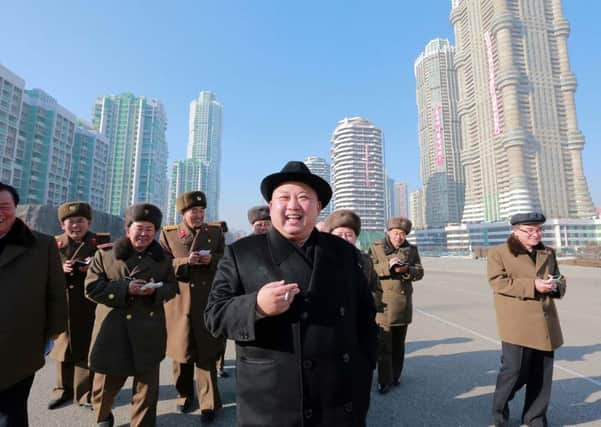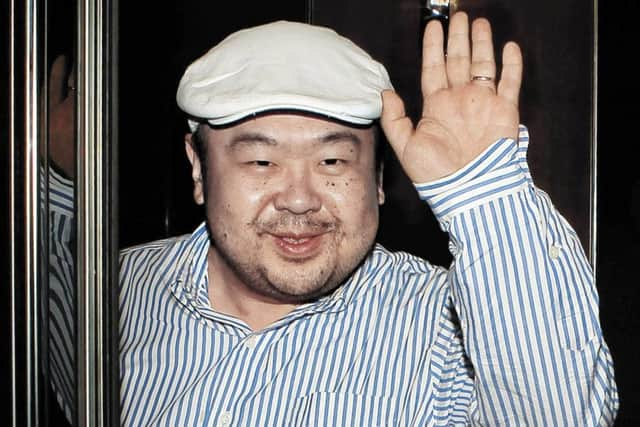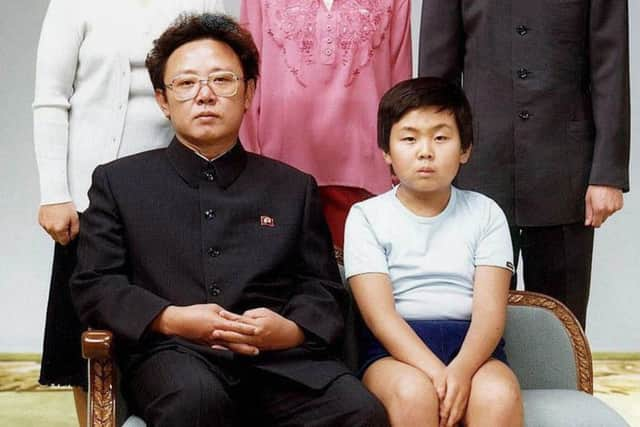North Korea: On the trail of Dear Brother's assassins


If – by his non-attendance – Jong-nam hoped to signal a relinquishing of any claim to power, and therefore to secure a future free from assassination attempts, he seems to have underestimated the ruthlessness and paranoia of a regime which would go on to execute more than a hundred state or military officials. Or, alternatively, the will of one of its enemies to undermine it.
Last week, Jong-nam died after being ambushed in Kuala Lumpur International Airport as he prepared to board a flight to the Chinese territory of Macau. Like many events involving North Korea, the killing had all the drama and intrigue of a James Bond movie: a false identity (Jong-nam was travelling under the alias Kim Chol); a group of shady assassins – thought to include at least two women – and a lethal dose of chemicals, rumoured to be deadly pufferfish toxins. The sense of the surreal was completed when the blurry photo of the first suspect – a young woman wearing a T- shirt bearing the slogan “LOL” – became a viral hit, and opportunists cashed in by flogging copies on the back of the murder.
Advertisement
Hide AdAdvertisement
Hide AdSince capturing the “LOL” suspect – Doan Thi Huong, 28, who was travelling on a Vietnamese passport – Malaysian detectives have arrested three more people: Siti Aisyah, 25, from Banten in Indonesia, her boyfriend, Muhammad Farid Bin Jalaluddin, 26, from Malaysia, and a North Korean named Ri Jong Chol, 46. But there is still confusion over who ordered the attack and why, with each new rumour bringing more questions than answers.


For example, if Jong-nam truly feared for his life – and wrote, begging to be spared after a failed assassination attempt in 2012 – why was he so casual about his use of Facebook and emails? And is there any connection between his killing and North Korea’s ballistic missile test last Sunday, or the birthday of the late Dear Leader, Kim Jong-il, which was celebrated in the usual, understated way (dancing, treats, flowers laid at the feet of statues) on Thursday?
Establishing the “truth” in North Korea is made more difficult by the secrecy in which the hermit kingdom is cloaked, by the wild speculation such secrecy breeds, and by the number of countries with an axe to grind. Lee Cheol-woo, the chairman of South Korea’s National Assembly Intelligence Committee, insists Jong-nam was murdered by North Korean agents, but it is not clear on what evidence he is basing his claim. As of Friday night, it was still unclear whether the poison was administered via a spray, a rag over the mouth or a hypodermic needle, never mind on whose orders the attack was carried out. With Malaysian police refusing to hand over the body to North Korea or release autopsy details until they are given DNA from his family, “facts” are proving hard to come by.
Given the family rifts and the regime’s history of bumping off “troublesome priests”, however, it is unsurprising the finger of blame is being pointed at Kim Jong-un. For years Jong-nam – Kim Jong-il’s oldest son, born to former actress Sung Hye-rim – was his favourite. He was sent off to study in Geneva and then Moscow and was trusted to travel with his father to Shanghai to meet senior officials in information technology. But in the early 2000s his life began to veer off course. Having travelled abroad, he appeared to feel stifled by life in North Korea and to be looking for a means of escape. A gambler with playboy tendencies, he started making secret trips to Tokyo, where he frequented a $350-an-hour bathhouse in Yoshiwara, the city’s red light district. Back home, he began to advocate reform. Then, in 2001, came the moment of ignominy that was to turn him into an outcast: his arrest at Narita Airport in Tokyo. Caught travelling on a false passport bearing the Chinese alias Pang Xiong – or “fat bear” – he told officials he had been trying to visit Disneyland.
From then on, his star began to wane. North Korea has a strict tradition of primogeniture, but the Korean People’s Army waged a campaign to cast Jong-il’s latest consort, Ko Yong-hui, a former dancer, as “the Respected Mother”, and her sons, Kim Jong-chul and Jong-un as his rightful heirs. In the end, Jong-il decided Jong-chul was too “effeminate” for the role and chose Jong-un to succeed him.


Since 2003, Jong-nam had lived in exile, in Macau and Beijing, raising, it is rumoured, separate families in each city. Overweight and louche-looking, he is said to have feared for his life, despite being afforded a degree of protection and financial assistance by China. From time to time, he criticised the regime.
The murder of Jong-nam certainly bears some of the hallmarks of Kim Jong-un’s bloody reign. For the past five years, the new leader has ruled through fear, consolidating his power by arbitrarily executing government officials and military leaders, often for minor infractions. Defence minister Hyon Yong-choi, for example, was taken out with an anti-aircraft gun in front of hundreds of spectators after falling asleep at a public event, while vice-premier Kim Yong-jin was killed by firing squad supposedly for slouching.
One of the victims of Jong-un’s purges was Jang Song-thaek, the uncle who stood with him at Jong-il’s hearse. Jang and his wife (Jong-il’s sister Kyung-hee) had helped to raise Jong-nam after his mother was rejected and packed off to Moscow. Jang was executed in 2014, though not, as was originally reported, after being stripped naked and ripped apart by dogs.
Advertisement
Hide AdAdvertisement
Hide AdNorth Korea also has a long tradition of using female agents. Jong-il’s father Kim Il-sung started recruiting pretty girls from high schools and universities after his original plan to abduct businessmen from Japan, South Korea and Thailand and turn them into spies failed when they proved resistant to brainwashing. The girls were trained in the arts of espionage and sex, and sent out to seduce politicians, journalists and other figures who might have access to secrets. Some would get pregnant and use the babies to blackmail their victims.


The most notorious female agent is Kim Hyon-hui who – together with a male accomplice – planted a bomb on Korean Air Flight 858, killing 115 people in 1987, in an attempt to dissuade people from attending the Olympics in Seoul the following year. Kim Hyon-hui took cyanide on her arrest, but didn’t die. She was pardoned by the South Korean government in exchange for telling them everything she knew, and still lives there under protection.
All this seems to point to North Korea’s involvement in Jong-nam’s death. Yet, there are doubts over how much of a threat he really posed to the country. He neither expressed nor demonstrated any ambition to lead, and had kept his head down in recent years, so the timing is a puzzle. Did China still look to him as a realistic alternative to a leader hell-bent on enhancing his country’s nuclear capabilities? Or was Jong-un in the grip of the kind of paranoia that sees enemies lurking everywhere?
Expert on North Korea, Aidan Foster-Carter, suggests it’s possible Jong-nam was planning to defect to South Korea. Perhaps Jong-un was rattled by a recent South Korean newspaper report suggesting his half-brother had tried to do so several years ago. North Korea does not believe hostilities between the two nations have been resolved, and any suggestion Jong-nam was moving to the affluent democracy would have been an affront to the dictator’s dignity.
But Foster-Carter also moots another possibility. “What if the killing was not ordered by Kim Jong-un, but rather done to impress him?” he asks. “In personalised tyrannies, agencies vie to show their loyalty to the leader by going above and beyond.” In January, Jong-un sacked his chief henchman, Kim Won-hong, who as minister of state security headed the feared political police, or Bowibu. “What better way for the Bowibu to prove their fealty and regain the young leader’s favour than the spectacular elimination of his disloyal sibling? Timed, moreover, as a gift for 16 February: the birthday of their father, Kim Jong-il.”


All of this, however, assumes the impetus for Jong-nam’s killing did indeed come from North Korea. Dr Chris Ogden, senior lecturer in Asian Security at St Andrews University’s School of International Relations, believes it would be a mistake to jump to this conclusion given how little we know about what goes on in the country.
“It is very difficult to tell what’s happening inside. There are very few reports other than hearsay,” says Ogden. “We put characteristics on the leader as if we understand him, but we really don’t. It seems amazing Jong-nam died in the morning, but by the afternoon, other countries were already saying they knew who had done it.”
And there are aspects of Jong-nam’s murder which don’t fit the North Korean MO. The woman with the “LOL” T-shirt, for instance, does not come across as a highly trained operative, but as a naive amateur who may have been duped into taking part in what she thought was a prank. That she appears to have made no attempt to kill herself when captured, and that her female accomplice has been confirmed as Indonesian, has also raised doubts.
Advertisement
Hide AdAdvertisement
Hide AdOgden says there are other theories as to who might be behind the killing, with some reports hinting at Chinese involvement. “I don’t think that’s true because they’re not interested and it would create instability for them,” he says. “But it’s possible it could be the South Koreans or the Japanese. North Korea has tried to act against them in the past by assassinating their officials and they could, in turn, be trying to put some pressure on [Jong-un].”
Ogden says the timing must also be taken into account. “I can’t get past the coincidence: they test the ballistic missile and then, suddenly, two days later, Jong-un’s half-brother is assassinated. This suggests it’s not the North Koreans, it’s somebody else,” he says.
“I would say it’s not China or Russia, because they are both too close to the North Koreans. But I think it’s likely to be some other [country] maybe as some kind of response to the missile test or a way of showing ‘if you want to threaten us, we can threaten you’.”
If Chinese officials believe Jong-un is behind the killing they will be angry as it strips them of leverage (in the form of an asset) and could be interpreted as a personal insult. Tensions between the two countries, whose current leaders have never met, worsened after the execution of Jang Song-thaek, an advocate of Chinese-style economic reform and the go-to person for officials in Beijing.
More recently, China has been under pressure to do more to stop North Korea’s nuclear and missile testing. According to Yonhap News Agency, Beijing rejected a $1 million shipment a day after North Korea’s latest missile test.
The death of Jong-nam will cause further friction, according to Daniel Pinkston, a lecturer in international relations at Troy University in Seoul, although China may be reluctant to punish an allied government whose stability is paramount to its regional interests.
Global Times columnist Ding Gang warned the killing had made the task of reining in North Korea’s nuclear programme more difficult.
“North Korea’s nuclear facilities and missile bases are located near China’s border,” he wrote. “Once the situation in the Korean Peninsula spirals out of control, the facilities will be primary targets or the final fortress of North Korea’s defence. Either way, the effects on China will be severe.”
Advertisement
Hide AdAdvertisement
Hide AdHe said Jong-nam’s death could even reinforce destabilising calls for tougher action to force “regime change” in Pyongyang.
Whoever is responsible, the curious killing of Kim Jong-nam has lobbed another grenade into an already volatile region, and reminded the world – once again – of North Korea’s terrifying unknowability.